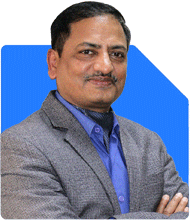Ramalingam Kalirajan |10893 Answers |Ask -Follow
Mutual Funds, Financial Planning Expert - Answered on May 30, 2024
He has an MBA in finance from the University of Madras and is a certified financial planner.
He is the director and chief financial planner at Holistic Investment, a Chennai-based firm that offers financial planning and wealth management advice.... more

Dear Sir, I am 40 year old and I have following MFs. My goal are 50L for child marraige ( after next 10 years) and retirment fund 1 cr and monthly pension of 50k per month post retirement. I invest 2000 per month in each. Pls suggest Aditya Birla Sun Life Mfg Equity Fund - Aditya Birla Sun Life Tax Relief 96 - Reg - G Axis Bluechip fund Canara Robeco Emerging Eqities Canara Robeco Equity Tax Saver HDFC Gold Trader Fund Growth - Direct HDFC Tax saver ICICI Prudential Technology Fund - Growth 360 One Focused Equity Fund - Growth Mirae Asset Emerging Bluechip Fund - Growth Mirae Asset Tax Saver Fund G Motilal Oswal NASDAQ 100 ETF Parag Parikh Flexi Cap Fund Quant Tax Plan
You have two primary financial goals. First, Rs 50 lakhs for your child's marriage in the next 10 years. Second, Rs 1 crore for retirement along with a monthly pension of Rs 50,000 post-retirement.
Both these goals require careful planning and disciplined investing.
Assessing Your Current Portfolio
Your current investments are diversified across various equity mutual funds. This diversification is a good strategy for risk management.
You invest Rs 2000 per month in each fund. This consistent investment is a commendable approach.
Equity Mutual Funds
Equity mutual funds are great for long-term wealth creation. They have the potential for high returns, which is essential for meeting your financial goals.
However, actively managed funds can outperform index funds in certain market conditions. This is due to professional fund management, which can adapt to market changes.
Tax-Saving Funds
You have invested in tax-saving funds, which is beneficial for tax deductions under Section 80C. These funds also invest in equities and can offer good returns.
However, consider the lock-in period of three years. Ensure these investments align with your liquidity needs.
Sectoral Funds
Your portfolio includes sectoral funds, which focus on specific sectors like technology. These funds can deliver high returns but come with higher risks.
Diversify across sectors to manage risk effectively. Avoid over-concentration in any one sector.
Gold Funds
You have invested in gold funds, which add stability to your portfolio. Gold acts as a hedge against inflation and economic uncertainties.
However, gold should be a smaller portion of your portfolio as it does not provide regular income.
International Funds
International funds give exposure to global markets, which can offer diversification benefits. These funds can help mitigate risks related to domestic market downturns.
However, be mindful of currency risk and geopolitical factors that can impact returns.
Direct vs. Regular Funds
You have chosen some direct funds. Direct funds have lower expense ratios, leading to slightly higher returns.
However, regular funds offer the benefit of advice from a Certified Financial Planner (CFP). This guidance can be crucial for making informed decisions.
Rebalancing and Monitoring
Regularly review and rebalance your portfolio to stay aligned with your goals. Market conditions and personal financial situations change, requiring adjustments in your investments.
Consider consulting a CFP for professional advice on rebalancing.
Conclusion
Your current investments reflect a thoughtful approach towards achieving your financial goals. Continue with disciplined investing and regular reviews.
Ensure diversification across different types of funds to balance risk and returns. Seek professional advice when needed to stay on track.
Best Regards,
K. Ramalingam, MBA, CFP,
Chief Financial Planner,
www.holisticinvestment.in
You may like to see similar questions and answers below
Samraat Jadhav |2508 Answers |Ask -Follow
Stock Market Expert - Answered on Jun 22, 2023
Sanjeev Govila | Answer |Ask -Follow
Financial Planner - Answered on Feb 06, 2024
Ramalingam Kalirajan |10893 Answers |Ask -Follow
Mutual Funds, Financial Planning Expert - Answered on Apr 30, 2024
Samraat Jadhav |2508 Answers |Ask -Follow
Stock Market Expert - Answered on Jun 11, 2024
Ramalingam Kalirajan |10893 Answers |Ask -Follow
Mutual Funds, Financial Planning Expert - Answered on Jul 22, 2024
Ramalingam Kalirajan |10893 Answers |Ask -Follow
Mutual Funds, Financial Planning Expert - Answered on Dec 15, 2025
Ramalingam Kalirajan |10893 Answers |Ask -Follow
Mutual Funds, Financial Planning Expert - Answered on Dec 15, 2025
Radheshyam Zanwar |6746 Answers |Ask -Follow
MHT-CET, IIT-JEE, NEET-UG Expert - Answered on Dec 15, 2025
Ramalingam Kalirajan |10893 Answers |Ask -Follow
Mutual Funds, Financial Planning Expert - Answered on Dec 15, 2025
Ramalingam Kalirajan |10893 Answers |Ask -Follow
Mutual Funds, Financial Planning Expert - Answered on Dec 15, 2025
Ramalingam Kalirajan |10893 Answers |Ask -Follow
Mutual Funds, Financial Planning Expert - Answered on Dec 15, 2025
Samraat Jadhav |2508 Answers |Ask -Follow
Stock Market Expert - Answered on Dec 15, 2025
Ramalingam Kalirajan |10893 Answers |Ask -Follow
Mutual Funds, Financial Planning Expert - Answered on Dec 15, 2025
Reetika Sharma |425 Answers |Ask -Follow
Financial Planner, MF and Insurance Expert - Answered on Dec 15, 2025
Radheshyam Zanwar |6746 Answers |Ask -Follow
MHT-CET, IIT-JEE, NEET-UG Expert - Answered on Dec 15, 2025























